
Drosera, commonly known as the sundews, is one of the largest genera of carnivorous plants, with at least 194 species. These members of the family Droseraceae lure, capture, and digest insects using stalked mucilaginous glands covering their leaf surfaces. The insects are used to supplement the poor mineral nutrition of the soil in which the plants grow. Various species, which vary greatly in size and form, are native to every continent except Antarctica.

Droseraceae is a family of carnivorous flowering plants, also known as the sundew family. It consists of approximately 180 species in three extant genera. Representatives of the Droseraceae are found on all continents except Antarctica.

Drosophyllum is a genus of carnivorous plants containing the single species Drosophyllum lusitanicum. In appearance, it is similar to the related genus Drosera, and to the much more distantly related Byblis.
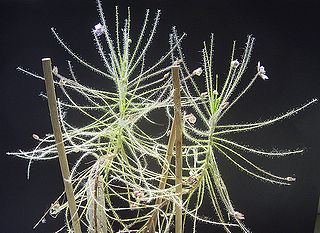
Byblis is a small genus of carnivorous plants, sometimes termed the rainbow plants for the attractive appearance of their mucilage-covered leaves in bright sunshine. Native to western Australia, it is the only genus in the family Byblidaceae. The first species in the genus was described by the English botanist Richard Anthony Salisbury in 1808. Eight species are now recognized.
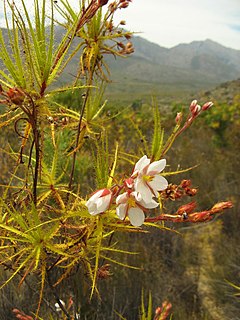
Roridula is a genus of evergreen, insect-trapping shrubs, with two species, of about 1⅓–2 m. It is the only genus in the family Roridulaceae. It has thin, woody, shyly branching, upright, initially brown, later grey stems, with lance- to awl-shaped leaves crowded at their tips. The star-symmetrical flowers consist from the outside in of five, green or reddish, free sepals, alternating with five white, pink or purple, free petals. Further to the middle and opposite the sepals are five stamens with the anthers initially kinked down. These suddenly flip up if the nectar-containing swelling at its base is being touched. The center of the flower is occupied by a superior ovary. The leaves and sepals carry many sticky tentacles of different sizes, that trap insects. Roridula does not break down the insect proteins, but bugs of the genus Pameridea prey on the trapped insects. These later deposit their feces on the leaves, which take up nutrients from the droppings. The species can be found in the Western Cape province of South Africa. They are commonly known as dewstick or fly bush in English and vlieëbos or vlieëbossie in Afrikaans.
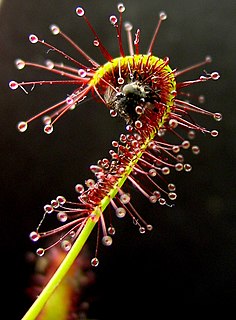
Drosera capensis, commonly known as the Cape sundew, is a small rosette-forming carnivorous species of perennial sundew native to the Cape in South Africa. Because of its size, easy to grow nature, and the copious amounts of seed it produces, it has become one of the most common sundews in cultivation, and thus, one of the most frequently introduced and naturalised invasive Drosera species.

Drosera rotundifolia, the round-leaved sundew or common sundew, is a carnivorous species of flowering plant that grows in bogs, marshes and fens. One of the most widespread sundew species, it has a circumboreal distribution, being found in all of northern Europe, much of Siberia, large parts of northern North America, Korea and Japan but is also found as far south as California, Mississippi and Alabama in the United States of America and in New Guinea.

Drosera spatulata, the spoon-leaved sundew, is a variable, rosette-forming sundew with spoon-shaped leaves. The specific epithet is Latin for "spatula shaped," a reference to the form of the leaves. This sundew has a large range and occurs naturally throughout Southeast Asia, in southern China and Japan, Micronesia, New Guinea through to the eastern territories of Australia and Tasmania and New Zealand. Variants are often known by the localities in which they are found. The plant does not form hibernacula in winter, and is easily grown using the same methods as Drosera capensis.

Drosera regia, commonly known as the king sundew, is a carnivorous plant in the sundew genus Drosera that is endemic to a single valley in South Africa. The genus name Drosera comes from the Greek word droseros, meaning "dew-covered". The specific epithet regia is derived from the Latin for "royal", a reference to the "striking appearance" of the species. Individual leaves can reach 70 cm (28 in) in length. It has many unusual relict characteristics not found in most other Drosera species, including woody rhizomes, operculate pollen, and the lack of circinate vernation in scape growth. All of these factors, combined with molecular data from phylogenetic analysis, contribute to the evidence that D. regia possesses some of the most ancient characteristics within the genus. Some of these are shared with the related Venus flytrap (Dionaea muscipula), which suggests a close evolutionary relationship.

Drosera pedicellaris is a pygmy species of the sundew genus (Drosera). It was discovered in 1997 and described in 2002 by Allen Lowrie.
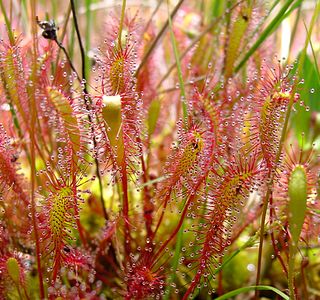
Drosera anglica, commonly known as the English sundew or great sundew, is a carnivorous plant species belonging to the sundew family Droseraceae. It is a temperate species with a generally circumboreal range, although it does occur as far south as Japan, southern Europe, and the island of Kauaʻi in Hawaiʻi, where it grows as a subtropical sundew. It is thought to originate from an amphidiploid hybrid of D. rotundifolia and D. linearis, meaning that a sterile hybrid between these two species doubled its chromosomes to produce fertile progeny which stabilized into the current D. anglica.

Drosera madagascariensis is a carnivorous plant of the sundew genus (Drosera). It was described in 1824 by A. P. de Candolle and is native to Africa.

Drosera intermedia, commonly known as the oblong-leaved sundew, spoonleaf sundew, or spatulate leaved sundew, is an insectivorous plant species belonging to the sundew genus. It is a temperate or tropical species native to Europe, southeastern Canada, the eastern half of the United States, Cuba and northern South America.

Drosera hartmeyerorum is a summer-growing annual sundew that is native to the north of Western Australia. It was discovered in 1995 by Siegfried and Irmgard Hartmeyer. Drosera hartmeyerorum has long scrambling leaves which readily curl around any unfortunate insect that lands on the leaves. One major thing that separates this sundew from others are the round yellow trichomes at the base of the leaves. The function of the yellow trichomes is uncertain. Like most sundews, it grows in warm wet, sandy, peaty areas with high humidity and low nutrient levels in the soil.

A protocarnivorous plant, according to some definitions, traps and kills insects or other animals but lacks the ability to either directly digest or absorb nutrients from its prey like a carnivorous plant. The morphological adaptations such as sticky trichomes or pitfall traps of protocarnivorous plants parallel the trap structures of confirmed carnivorous plants.
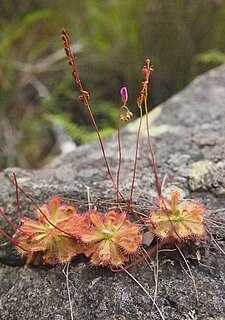
Drosera burmannii, the tropical sundew, is a small, compact species in the carnivorous plant genus Drosera. Its natural geographical range includes the tropical and subtropical regions of Asia, Australia, India, Japan,southeast Asia,Oceania, Africa and China 's Guangxi, Guangdong, Yunnan, Fujian, Taiwan. It normally spans only 2 cm (0.8 in) in diameter. It is one of the fastest trapping sundews as well, and its leaves can curl around an insect in only a few seconds, compared to the minutes or hours it takes other sundews to surround their prey. In nature, D. burmannii is an annual, but in cultivation, when grown indoors during the cold months, it can live for many years. Since D. burmannii is an annual, it produces large amounts of seed. Drosera burrmannii has been considered a powerful rubefacient in Ayurveda.
Drosera solaris is a species of sundew native to the highlands of Guyana. It is thought to be most closely related to Drosera felix and Drosera kaieteurensis.
Drosera uniflora is a species in the carnivorous plant genus Drosera that is native to southern Chile, Argentina, and the Falkland Islands. It is a tiny sundew with a solitary white flower as its name would suggest. Stalked glands on its leaves, which secrete sticky mucilage at the tips, are used to capture and hold insect prey, from which the plant derives the nutrients it cannot obtain in sufficient quantity from the soil. It was formally described in 1809 by botanist Carl Ludwig Willdenow.
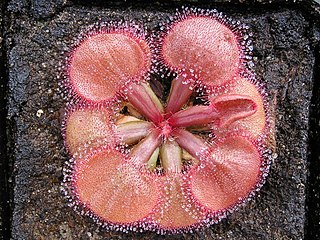
Drosera falconeri is a carnivorous plant in the genus Drosera. It is endemic to the Northern Territory of Australia.
Drosera peruensis is a carnivorous plant of the genus Drosera, commonly known as the Peruvian sundew. This Drosera species was first identified in Peru in 2002 by Tânia Regina dos Santos Silva and Mireya D. Correa following work to update the genus Drosera for the reference text, Flora Neotropica..


















